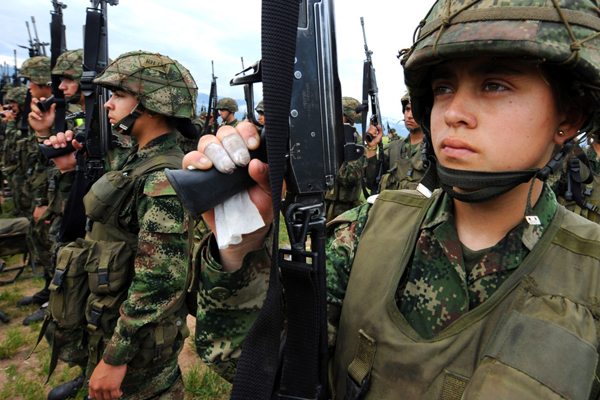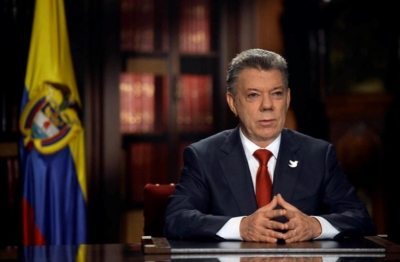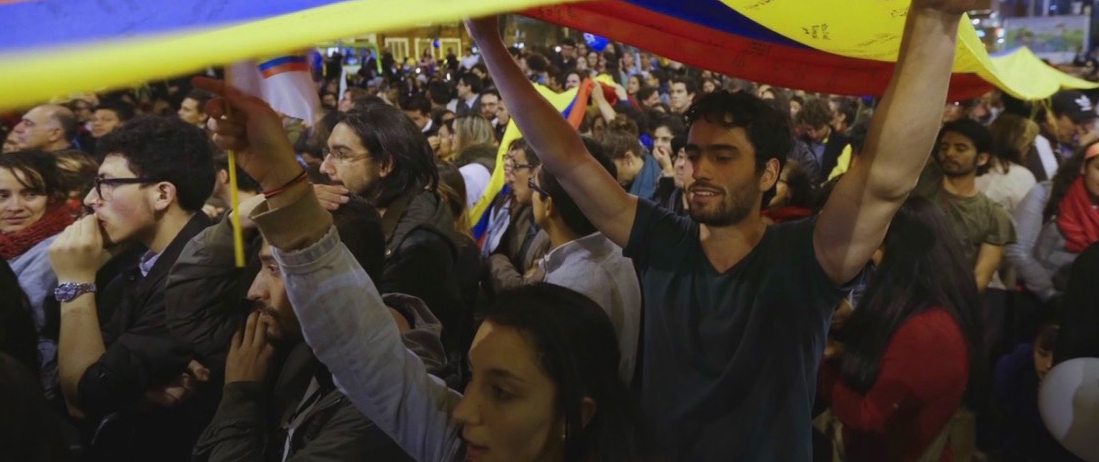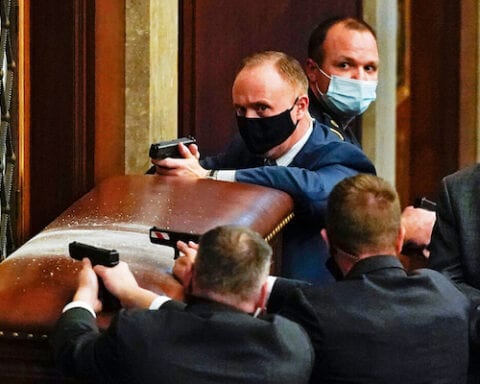FARC Havana peace deal sets the stage for lasting peace: But at what cost?
On August 24th, shortly after 7 PM local time, the nation of Colombia bid “Adios A La Guerra,” bringing the longest running war in the Americas to a historic and hopeful end. Following four years of peace negotiations, the Colombian Government and the Revolutionary Armed Forces of Colombia (FARC)—the nation’s oldest and largest Marxist rebel group—inked a peace accord in Havana, hoping to put 52 years of internal armed conflict behind a nation whose fastest growing economy in South America is already on the path toward a brighter future.
Earlier in the day, social media activity from FARC’s most senior commander—Rodrigo Londono, who uses the alias, Timoleón Jiménez —indicated an agreement was in the works. Jiménez tweeted (translated) “Let’s rescue values that have allowed for humans to exist: dialogue, solidarity, tolerance and love #VamosPorLaPaz” around 5:13 AM local time. President Juan Manuel Santos announced early on in the day, “Today I hope to give historic, very important news to the country.” By evening, the sixth in a series of, at times, complex accords between the two parties was officially reached.
Rescatemos valores que han permitido al ser humano existir: diálogo, solidaridad, tolerancia y amor #VamosPorLaPaz https://t.co/bWqDkEQZLp
— Timoleón Jiménez (@Timochenko_FARC) August 24, 2016
A brief look at the timeline that brought the nation to this historic point notes key moments of headway between Colombia and the FARC opposition:
- In January of 2011, FARC leader at the time, Alfonso Cano, granted permission for secret peace talks to begin with the Colombian government. Just after Cano’s death, Fidel Castro sent a delegation to meet with Timoleón Jiménez, Cano’s successor, during which time Jiménez agreed peace talks would be continued under his leadership.
- In June of 2012, Colombia’s Congress ratified a “Peace Framework Law,” delineating the general path for the rebel group to follow.
- In May of 2013, following the death of FARC private sympathizer Venezuelan President Hugo Chavez, the first of five official negotiating concessions was announced: property restitution and agrarian development. In November 2013, the second negotiating point was conceded: the possibility for future FARC participation in politics. By May of last year, the third stipulation was reached, a scaling back on the illegal drug trade in the country. By December, both sides had agreed to the fourth negotiating point, creating a tribunal to judge war crimes and offer restitution to the victims.
- This May, FARC agreed to release all child soldiers involved in the fight.
- On June 23rd, both sides ushered in the fifth negotiating concession: disarming and demobilizing FARC members, with an official ceasefire being announced.
Last month, just two days before Colombia’s Independence Day, the nation’s top court approved a nationwide referendum in which the people would officially vote on the peace agreement, following an internal deal between the government and FARC.

The historic agreement ushered in a few final key provisions. Firstly, among these stipulations, most guerillas will receive lighter sentences and those charged with serious crimes will have access to “alternative” penalties that don’t include jail time, so long as they confess to their crimes. FARC will also have to eliminate the illicit crops that fuel the cocaine trade, and the government has agreed to funnel money initially directed toward war efforts to long-neglected rural areas.
We’re not against peace.
What we’re against are these agreements that hand the country over to the FARC and don’t lead to peace but more violence.
– Alvaro Uribe, former President of Colombia
At its heart, the deal clears the path for FARC to establish itself as a political party. With close to 8000 fighters, the rebel group’s ability to form a governmental stronghold is feared by many locals. The finalized text of the deal will be available via social media and online, once President Santos presents the document to Congress.
But for most Colombians—the specifics of the deal aside—Wednesday’s monumental farewell to arms was simply a beacon of hope that a war that had consumed most of their lifetimes was, at long last, winding down. One key hurdle which persists on the road to peace, however, is the ratification of the deal before the plebiscite.
For many Colombians, the accord has proven too generous toward the FARC. Alvaro Uribe, former President of Colombia and current leader of the country’s most active “no” vote party, Centro Democratico, said, “We’re not against peace. What we’re against are these agreements that hand the country over to the FARC and don’t lead to peace but more violence.” Uribe also noted that the accord could possibly spiral the country into socialism, a path its Venezuelan neighbor embodies. Furthermore, Colombian President Juan Manuel Santos has grounded his legacy on pillars of peace, and the time has now come for him to sell the accord to his people.

The Government has four months to take the vote to the public, in a linchpin referendum that will give teeth to the internal agreement. If the people vote for the deal in the referendum, the bill will move on to Congress and, if the governmental body approves it, the accord will finally go to the constitutional council. Here, if approved, the President will officially sign the text into law. The referendum has been set for October 2, 2016, according to President Santos. 13% of the electorate must vote “Yes” at the ballot in order for the accord to be ratified. If this threshold is achieved, within 90 days, FARC will hand over its weapons to UN-sponsored monitors.
In the last year since the ceasefire, violence at the hand of FARC has reached a 52-year low, with only 4 deaths officially reported at the hands of the rebel group. The recent numbers are not to overshadow almost half a century of violence at the hand of this fight, however. The civil war has claimed over 220,000 lives in the last 50 years, with almost 7 million internally displaced.
Nevertheless, as the two-time “happiest” country in the world moves forward on its road to peace, cries of “Si, Se Puede” and “Sia La Paz” erupted as hopeful Colombians took to the streets of Bogota. Locals sang the national anthem, ¡Oh Gloria Inmarcesible!, at Parque de los Hippies in the country’s capital, as President Santos and the FARC Chief negotiator expressed messages of mutual optimism. “I believe we’ve won the most beautiful of all battles: peace,” tweeted FARC’s Ivan Marquez from the official FARC International Twitter account. President Santos remarked, “It’s a unique and historic opportunity. It will be the most important vote in our lifetime.”
Lima Charlie News
Lima Charlie provides global news, analysis and opinion by military veterans and service members Worldwide.
Please join us on Twitter at @LimaCharlieNews

![Image Peace for Colombia? FARC Havana Deal Promises End to 50 Year War [Lima Charlie News]](https://limacharlienews.com/wp-content/uploads/2016/08/Colombia-FARC-Peace.jpg)

![Image The rise and dominance of Colombia's private military contractors [Lima Charlie News]](https://limacharlienews.com/wp-content/uploads/2019/01/Colombias-Private-Military-Contractors-Lima-Charlie-News-480x384.png)
![Image NATO's embrace of Colombia signals Western insecurities about China in Latin America [Lima Charlie News][Photo: Mauricio Duenas Castaneda / EPA]](https://limacharlienews.com/wp-content/uploads/2018/06/NATOs-embrace-of-Colombia-signals-Western-insecurities-about-China-in-Latin-America-480x384.jpg)
![Image As Colombia’s economy moves forward, its history may slide backwards [Lima Charlie News] (Photo: Luis Acosta / AFP]](https://limacharlienews.com/wp-content/uploads/2018/06/title-480x384.jpg)



![Image Memorial Day may soon be a remembrance of democracy and those who had the courage to defend it [Lima Charlie News]](https://limacharlienews.com/wp-content/uploads/2018/05/Memorial-Day-may-soon-be-a-remembrance-of-democracy-and-those-who-had-the-courage-to-defend-it-Lima-Charlie-News-480x384.png)
![The Mind of Bolton - AUMF and the New Iran War [Lima Charlie News]](https://limacharlienews.com/wp-content/uploads/2019/05/Inside-the-mind-of-Bolton-Lima-Charlie-News-main-01-480x384.png)
![Image The rise and dominance of Colombia's private military contractors [Lima Charlie News]](https://limacharlienews.com/wp-content/uploads/2019/01/Colombias-Private-Military-Contractors-Lima-Charlie-News-150x100.png)
![Image NATO's embrace of Colombia signals Western insecurities about China in Latin America [Lima Charlie News][Photo: Mauricio Duenas Castaneda / EPA]](https://limacharlienews.com/wp-content/uploads/2018/06/NATOs-embrace-of-Colombia-signals-Western-insecurities-about-China-in-Latin-America-150x100.jpg)